How to Write Effective Prompts for AI
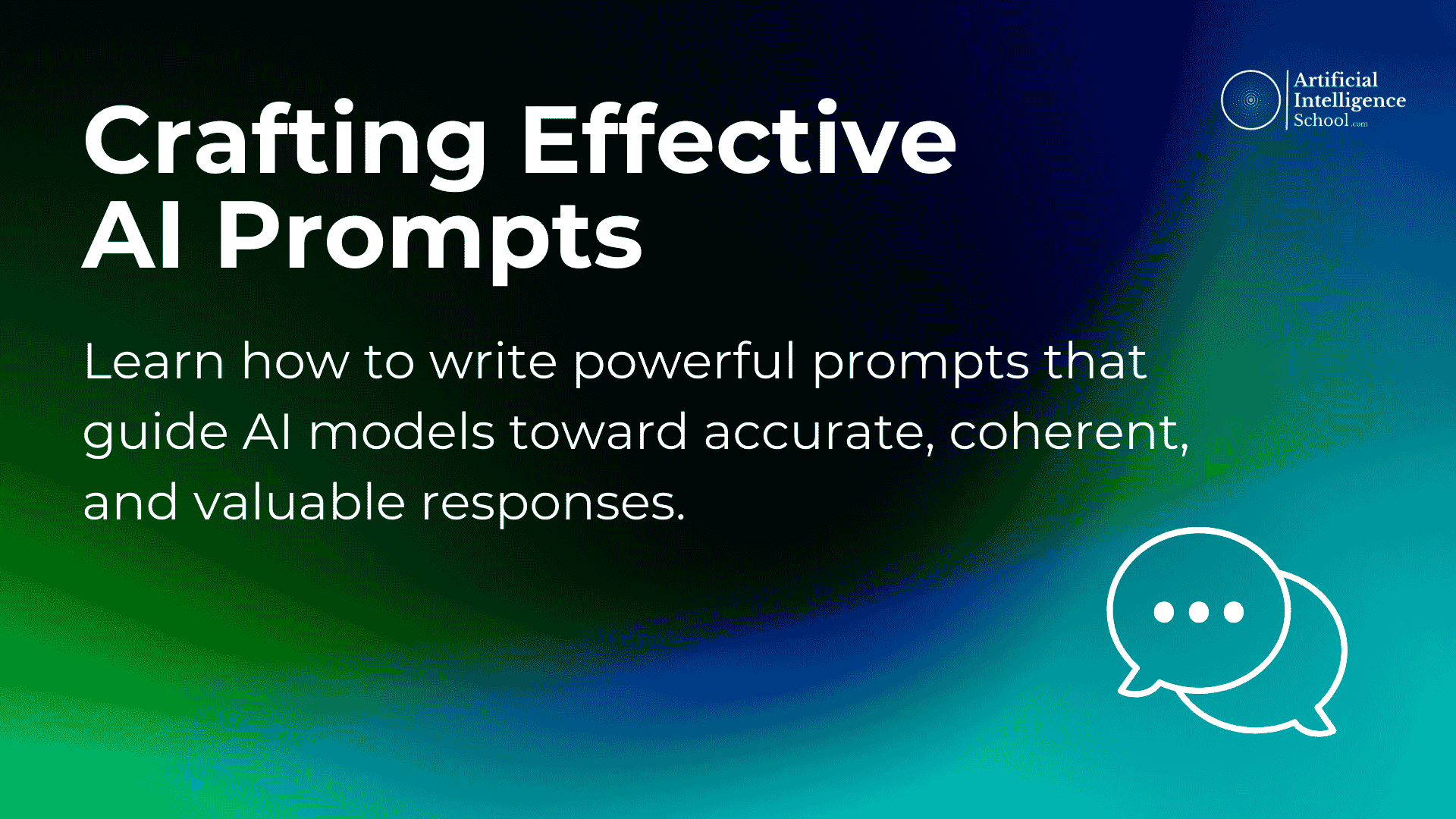
- Understanding AI and Prompts
- Key Principles of Effective Prompting
- Importance in Specialized Fields
- Optimizing Prompts for Better Results
- Types of Prompts
- Impact of Prompt Wording on AI Output
- Ethical Considerations in Prompt Engineering
- Prompt Examples for Content Creation
- Advanced Prompting Techniques
- The Future of Prompt Engineering
- Takeaway
Large language models (LLMs) like ChatGPT are revolutionizing human-computer interaction. These powerful AI models can generate creative text, translate languages, and answer a wide range of questions. However, to truly harness their capabilities, you need to know how to communicate effectively with them. This is where prompt engineering comes in.
Prompt engineering is the process of designing and optimizing prompts to guide AI models, particularly LLMs, toward generating the desired responses. Think of it as providing a roadmap for the AI, steering it toward the specific output you have in mind.
This blog post will delve deep into the world of prompt engineering, exploring various techniques and best practices to help you write effective prompts for AI. Whether you’re a seasoned AI developer or just starting your journey, this guide will equip you with the knowledge and skills to unlock the full potential of LLMs.
Understanding AI and Prompts
Before we dive into the specifics of prompt engineering, let’s understand how AI models work and the role prompts play in this process. AI models, especially LLMs, are trained on vast amounts of text data. This data is fed into the model, allowing it to learn the statistical relationships between words, phrases, and grammatical structures. Imagine teaching a child a language by exposing them to countless books and conversations. Over time, the child learns to understand and generate their own sentences. Similarly, AI models learn to understand and generate human-like text by analyzing massive datasets.
Prompts act as the input or instructions that guide the AI model’s response. They provide the context and direction for the model, influencing the quality and relevance of the output. A well-crafted prompt can significantly improve the accuracy, coherence, and usefulness of the AI’s response, while a poorly written prompt can lead to irrelevant or nonsensical outputs.
Prompts can take various forms, from simple questions to complex scenarios. You can even assign a specific role to the AI, such as “act as a native French speaker,” to influence the style and tone of the response. This flexibility allows you to tailor the AI’s output to your specific needs.
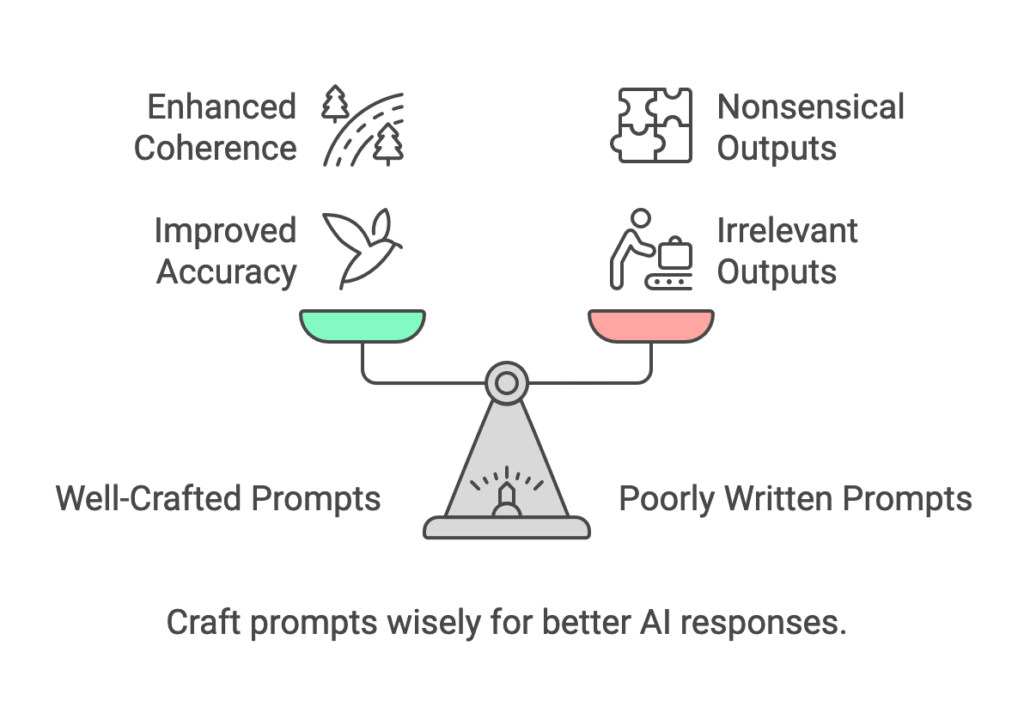
Key Principles of Effective Prompting
1. Clarity and Specificity
The foundation of a good prompt is clarity and specificity. Avoid ambiguity and be precise about what you’re asking for. Instead of a vague prompt like “Tell me about oceans,” provide more detailed instructions like “Provide an overview of the major oceans of the world and their unique characteristics.” The more specific your prompt, the better the AI can understand your intent and generate a relevant response.
2. Context and Background
Providing context and background information helps the AI understand your request better. If your prompt relates to a broader topic or requires specific knowledge, include that information in the prompt. For example, if you’re asking for a summary of a historical event, provide a brief background of the event and the key players involved. This context allows the AI to draw upon its knowledge base and generate a more informed and comprehensive response.
3. Structure and Formatting
A well-structured prompt with clear formatting can significantly improve the AI’s understanding. Use bullet points, numbered lists, or headings to organize your requests, especially when dealing with multiple instructions or questions. This helps the AI break down the task into smaller, more manageable chunks, leading to more accurate and organized outputs.
4. Conciseness
While providing context is important, avoid unnecessary information or overly lengthy prompts. Keep your prompts concise and to the point, focusing on the essential details. Overly long prompts can confuse the AI, leading to less relevant or coherent responses.
5. Examples and Demonstrations
Providing examples of the desired output can be incredibly helpful, especially for creative tasks. If you want the AI to generate a poem in a specific style, include an example of a poem in that style to guide the model. This gives the AI a concrete understanding of your expectations and helps it generate outputs that align with your vision.
6. Experiment with Different Formats
Don’t be afraid to experiment with different prompt formats to see what works best for your needs. You can try providing the AI with different personas or roles, framing your requests as open-ended questions, or using keywords strategically to guide the AI’s response.
7. Iterative Refinement
Don’t expect to get the perfect response on the first try. Prompt engineering often involves an iterative process of refining your prompts based on the AI’s responses. Experiment with different phrasings, structures, and examples to fine-tune your prompts and achieve the desired output. Each interaction with the AI provides valuable feedback that you can use to improve your prompts and get closer to your desired outcome.
Importance in Specialized Fields
Prompt engineering plays a key role in applications that require the AI to respond with subject matter expertise. For example, in medical diagnosis or legal research, a prompt engineer with experience in the field can guide the AI to reference the correct sources and frame the answer appropriately based on the question asked.
Optimizing Prompts for Better Results
Once you’ve crafted your initial prompts, it’s essential to optimize them for better results. This involves an ongoing process of observation, adjustment, and refinement:
- Observe AI Responses
Pay close attention to how the AI responds to your prompts. Are the responses relevant? Are they in the desired format? Are there any errors or inconsistencies? - Make Adjustments
Based on your observations, make adjustments to your prompts. Try rephrasing your requests, adding more context, or providing clearer examples. - Continually Refine
Think of your interaction with the AI as an ongoing dialogue. Continually refine your prompts based on the AI’s performance to improve the quality and relevance of the responses.
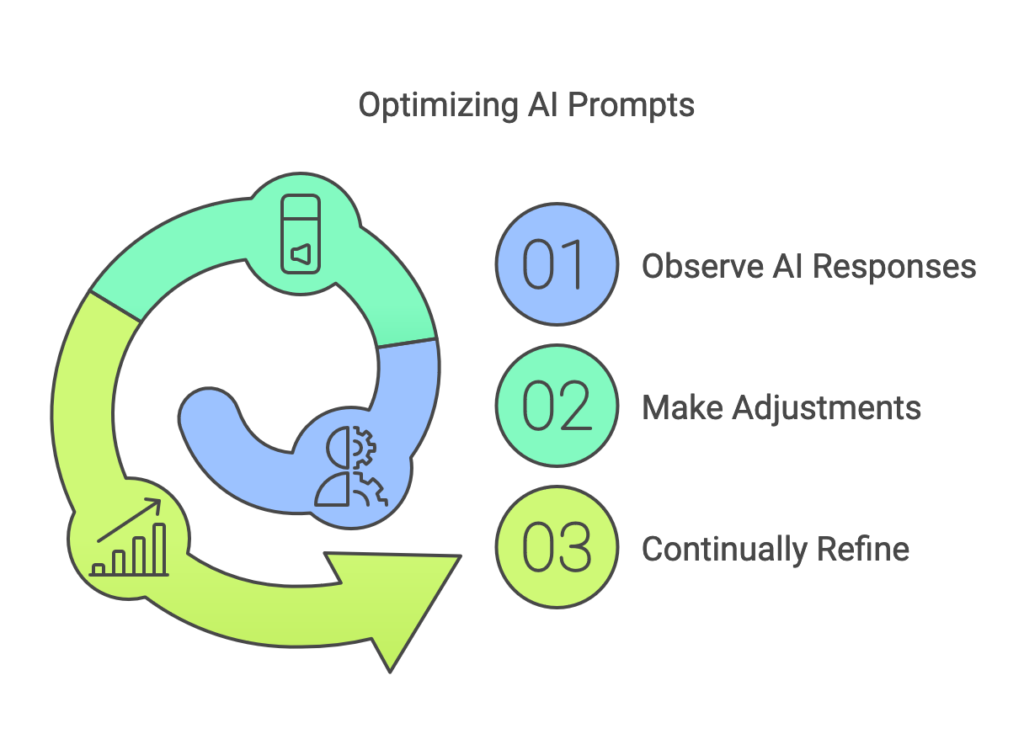
Types of Prompts
Understanding the different types of prompts can help you choose the most effective approach for your specific needs. Here’s a table summarizing some common types:
| Prompt Type | Description |
|---|---|
| Informational | Seek specific information or facts, similar to querying a search engine. |
| Creative | Aim to inspire creativity and generate new ideas, such as writing stories, poems, or scripts. |
| Instructional | Guide the AI to provide step-by-step instructions or processes, like explaining how to do something. |
| Completion | Provide an incomplete idea or text, and the AI is tasked with completing it. |
| Inferential | Require the AI to draw inferences or conclusions based on the information provided. |
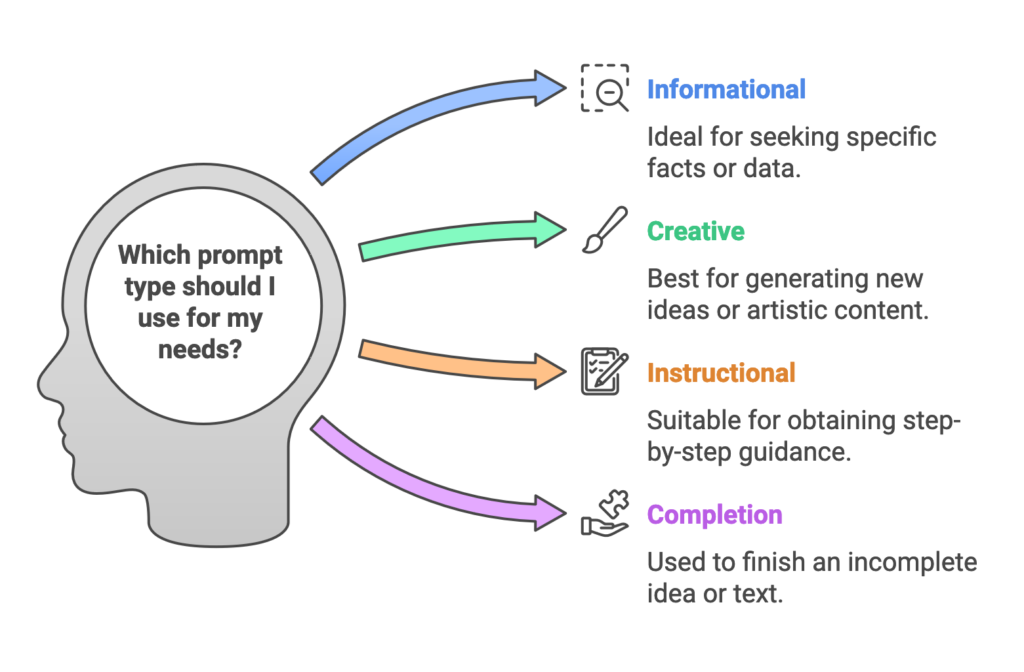
Impact of Prompt Wording on AI Output
The wording of your prompt can significantly impact the AI’s response. Even small changes in phrasing or word choice can lead to different outputs. For example, using active voice instead of passive voice can make your prompt clearer and more direct, resulting in a more focused response.
The length of your prompt can also influence the output. While conciseness is generally recommended, longer prompts with more details can be helpful for complex tasks or when you need to provide specific instructions.
It’s also important to be mindful of potential biases in your prompt wording. Using neutral language and avoiding stereotypes can help ensure that the AI’s response is fair and unbiased.
The level of precision in a prompt directly correlates with the quality of the AI’s output. A vague prompt like “Write a story” will likely result in a generic and uninspired story. However, a more precise prompt like “Write a science fiction short story set on Mars about a lone astronaut struggling for survival” will guide the AI to generate a more focused and engaging narrative.
Ethical Considerations in Prompt Engineering
As AI becomes more prevalent, it’s crucial to consider the ethical implications of prompt engineering. Here are some key ethical considerations:
- Bias
AI models can inherit biases from the data they are trained on. Prompt engineers need to be aware of these biases and take steps to mitigate them by carefully curating training data and evaluating prompt performance for fairness. For example, in job candidate screening, prompts that emphasize certain cultural or personal traits may unfairly disadvantage qualified individuals who do not align with those traits. - Misinformation
AI models can generate false or misleading information. Prompt engineers should design prompts that discourage the generation of harmful or inaccurate content and promote responsible AI usage. - Privacy
Prompts should be designed to protect user privacy and avoid the disclosure of sensitive information. Prompt engineers should ensure that AI models refuse to share private data. - Transparency
Users should be aware that they are interacting with an AI model. Prompt engineers should strive for transparency in AI interactions and provide clear indications when AI is being used.
Prompt Examples for Content Creation
Here are some sample AI prompts designed for blog content ideation:
- Trending Topics
“Generate a list of trending topics in [industry/niche/field] that would engage readers right now.” - Audience Questions
“What are the most common questions people ask about [topic]? Provide ideas for blog posts answering these questions.” - Seasonal Content
“Suggest blog post ideas related to [upcoming season or holiday], focusing on tips, recipes, or activities.” - Case Studies
“List potential case study topics showcasing successful projects or strategies in [industry/niche/field].” - Problem-Solving Ideas
“Identify common challenges faced by [target audience] and propose blog post ideas that offer solutions.”
Advanced Prompting Techniques
While the key principles discussed earlier provide a solid foundation for effective prompting, there are more advanced techniques that can further optimize your interactions with AI models. These techniques delve deeper into how prompts are processed and how you can fine-tune them for specific tasks.
- Tokenization
AI models break down text into smaller units called tokens. Understanding how tokenization works can help you craft prompts that are more easily processed by the model. - Model Parameter Tuning
Advanced users can fine-tune the parameters of an AI model to optimize its performance for specific tasks or domains. - Top-k Sampling
This technique involves selecting the top k most likely words or phrases during text generation, allowing you to control the diversity and creativity of the AI’s output.
The Future of Prompt Engineering
Prompt engineering is a rapidly evolving field, and its future is filled with exciting possibilities. Here are some potential trends:
- Adaptive Prompting
AI models may become capable of generating their own prompts based on the context, reducing the need for manual input. - Multimodal Prompts
With the rise of multimodal AI models that can process both text and images, prompt engineering may expand to include visual cues. - Personalized Prompts
AI models may become more personalized, tailoring their responses to individual user preferences and needs. - Increased Automation
Prompt engineering may become more automated, with tools and techniques that simplify the process of creating effective prompts. - Domain-Specific Integration
Prompt engineering is increasingly being integrated with domain-specific AI models, which are trained on industry-specific data. This allows for more accurate and relevant responses in fields like medicine, law, and finance. - Growing Industry
Prompt engineering is poised to become a lucrative industry with applications in diverse fields like healthcare, customer service, and marketing. Skilled prompt engineers will be in high demand to help organizations harness the power of AI in various domains.
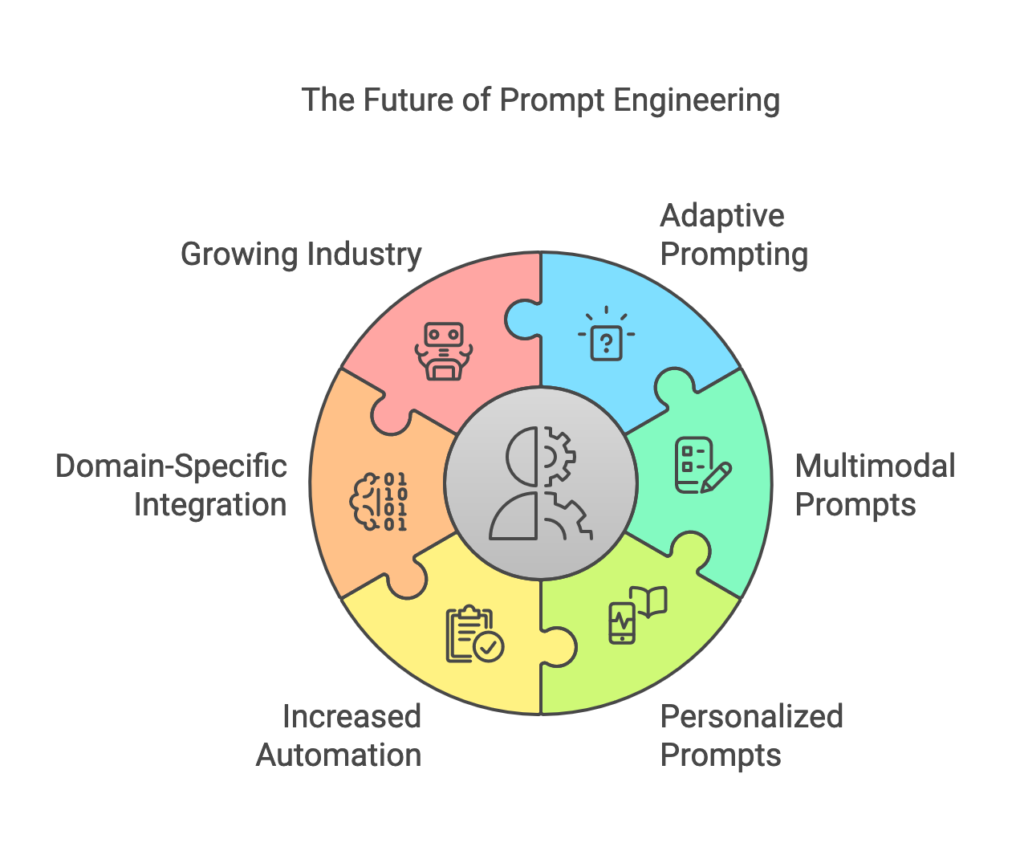
Takeaway
Prompt engineering is a crucial skill for anyone who wants to harness the full potential of AI. By understanding the principles of effective prompting and the different types of prompts, you can guide AI models to generate high-quality, relevant, and ethical outputs. As AI technology continues to evolve, prompt engineering will play an increasingly important role in shaping the future of human-AI interaction.
Start experimenting with different prompts, observe the AI’s responses, and refine your approach. With persistence and creativity, you can unlock the full potential of these powerful tools and make AI work for you in ways you never thought possible.


